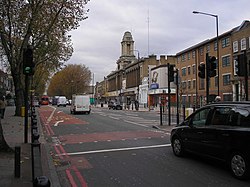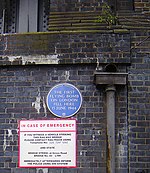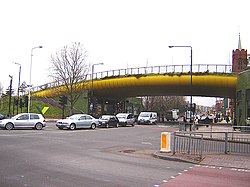Mile End
| Mile End | |
| Middlesex | |
|---|---|
 Mile End Road | |
| Location | |
| Grid reference: | TQ365825 |
| Location: | 51°31’29"N, 0°1’53"W |
| Data | |
| Post town: | London |
| Postcode: | E1, E3 |
| Dialling code: | 020 |
| Local Government | |
| Council: | Tower Hamlets |
| Parliamentary constituency: |
Bethnal Green and Bow Poplar and Limehouse |
Mile End is a Middlesex town stretching along the ancient route east out of the City of London, which here is known as the Mile End Road, and which forms the town's high street. Mile End is part of the East End; the towns and localities that have spread out to the east of the City. It is part of the Ossulstone Hundred.
Mile End developed on the London to Colchester road as one of the earliest suburbs of the City of London and the parish of Mile End Old Town was formed in 1855.
The name "Mile End" is recorded in 1288 as La Mile ende.[1] That name is Middle English but the meaning is the same in Modern English, namely a place a mile away, specificallybecause it lies a mile east of Aldgate, the eastern gateway of the City of London, along the London to Colchester road.[1] In around 1691 Mile End became known as Mile End Old Town because a new unconnected settlement to the west and adjacent to Spitalfields had taken the name Mile End New Town.[1]
History
Beginnings
Mile End historically formed a hamlet within the large ancient parish of Stebenheath (Stepney), in the Tower Division of the hundred. Whilst there are many references to settlements in the area, excavations have suggested there were very few buildings before 1300.
Mile End Road is an ancient route from London to the East, and was moved to its present day alignment after the foundation of Bow Bridge in 1110. In the mediæval period it was known as 'Aldgatestrete', as it led to the eastern entrance to the City of London at Aldgate. The area running alongside Mile End Road was known as Mile End Green, and became known as a place of assembly for Londoners, reflected in the name of Assembly Passage.
For most of the Middle Ages this road was surrounded by open fields on either side, but speculative developments existed by the end of the 16th century and continued throughout the 18th century.
The Stepney Green Conservation Area was designated in January 1973, covering the area previously known as Mile End Old Town. It is a large Conservation Area with an irregular shape that encloses buildings around Mile End Road, Assembly Passage, Louisa Street and Stepney Green itself. It is an area of exceptional architectural and historic interest, with a character and appearance worthy of protection and enhancement. It is north of the mediæval village of Stepney, which was clustered around St. Dunstan's Church.
Peasants' Revolt
After the Black Death had passed, the dynamics of society had radically changed. In 1381, an uprising against the tax collectors of Brentwood quickly spread first to the surrounding villages, then throughout the south-eastern counties of England, but it was the rebels of Essex, led by a priest named Jack Straw, and the men of Kent, led by Wat Tyler, who marched on London. On 12 June, the Essex rebels, comprising 60,000 men, camped at Mile End and on the following day the men of Kent arrived at Blackheath. On 14 June, the young king Richard II rode to Mile End where he met the rebels and signed their charter. Unfortunately, their subsequent behaviour caused the king to have the leaders and many rebels executed.[2]
Birth of London's Yiddish theatre
In 1883, Jacob P Adler arrived in London with a troupe of refugee professional actors. He enlisted the help of local amateurs, and the Russian Jewish Operatic Company made their debut at the Beaumont Hall, close to Stepney Green tube station. Within two years they were able to establish their own theatre in Brick Lane.[3]
People's Palace
Novelist and social commentator Walter Besant proposed a Palace of Delight[4] with concert halls, reading rooms, picture galleries, an art school and various classes, social rooms and frequent fêtes and dances. This coincided with a project by the philanthropist businessman, Edmund Hay Currie to use the money from the winding up of the Beaumont Trust,[5] together with subscriptions to build a People's Palace in the East End. Five acres of land were secured on the Mile End Road, and the Queen's Hall was opened by Queen Victoria on 14 May 1887. The complex was completed with a library, swimming pool, gymnasium and winter garden, by 1892, providing an eclectic mix of populist entertainment and education. A peak of 8000 tickets were sold for classes in 1892, and by 1900, a Bachelor of Science degree awarded by the University of London was introduced.[6]
In 1931, the building was destroyed by fire, but the Worshipful Company of Drapers, major donors to the original scheme, invested more to rebuild the technical college and create Queen Mary College in December 1934. A new People's Palace was constructed, in 1937, by the Metropolitan Borough of Stepney, in St Helen's Terrace. This finally closed in 1954.[7]
Second World War

Mile Ed was heavily hit during the Blitz, the Luftwaffe repeatedly bombing the East End to kill, drive out and demoralised the industrial workers who were keeping the docks and factories going.
Besides suffering heavily in earlier blitzes, Mile End was hit by the first V-1 flying bomb to strike London. On 13 June 1944, this 'doodlebug' impacted next to the railway bridge on Grove Road, an event now commemorated by a plaque. Eight civilians were killed, 30 injured and 200 made homeless by the blast.[8] The area remained derelict for many years, until cleared to extend Mile End park. Before demolition in 1993, local artist Rachel Whiteread made a cast of the inside of 193 Grove Road. Despite attracting controversy, the exhibit won her the Turner Prize for 1993.[9]
The legacy of the Blitz remains; the number of bombs which fell can never be known and many unexploded bombs are believed to remain buried here. In May 2007 for example during building work, a live bomb weighing 440 pounds was found north of Mile End station near Grove and Roman Roads. Approximately 100 local residents were evacuated and stayed with friends and family or the Mile End Leisure Centre until the bomb could be deactivated and removed.
Twentieth century
The Ragged School Museum, opened in 1990 in three canal side former warehouses in Copperfield Road, facing the western edge of the park, south of Mile End Road. The buildings previously housed Dr Barnado's Cooperfield Road Ragged School.
The East End has long been a breeding ground for radicalism and radical socialism. The Parliamentary constituency Mile End had a reputation as a Labour Party stronghold, but also sent Communist Member of Parliament to the House of Commons between 1945 and 1950. The Bethnal Green and Bow constituency in which Mile End is now placed has continued Mile End's tradition for electing wilder politicians by electing George Galloway from the Respect Party at the 2005 General Election. While from the late nineteenth to mid-twentieth centuries though a major demographic was a Jewish working-class population, by George Galloway's time a large Bangladeshi Muslim population was driving the vote.
Sights of the town

- Queen Mary College (main site), part of the University of London
- Barts and The London School of Medicine and Dentistry (parts on the same site)
The "Green Bridge" is an unusual feature. This structure, opened in 2000, allows Mile End Park to cross over the Mile End Road and makes an interesting contrast with the more usual approach of building bridges for cars. It contains garden and water features and some shops and restaurant space built in below.
Sport and leisure
- Football: Sporting Bengal United FC, who play at Mile End Stadium.
Mile End in popular culture
The town is rarely treated kindly in popular culture. It was immortalised (humorously but unfavourably) in the pop band Pulp's song, "Mile End," which was featured on the soundtrack to the film Trainspotting. The song describes a group of squatters taking up residence in an abandoned 15th-floor apartment in a run-down apartment tower.
A play called "Mile End" features not som much the town but the melancholy true incident of a man pushed in front of a train at Mile End Station.
The artistic director of the Olympic Opening Ceremony, Danny Boyle lives in Mile end. Boyle is also the director of Trainspotting
Transport

- London Underground
- Mile End, on the District, Hammersmith and City and Central Lines.
References
- ↑ 1.0 1.1 1.2 Mills, D. (2000). Oxford Dictionary of London Place Names. Oxford.
- ↑ R. B. Dobson, editor, (2002), The Peasants' Revolt of 1381 (History in Depth) ISBN 0-333-25505-4; a collection of source materials
- ↑ The Jewish Museum accessed on 31 March 2007
- ↑ In Walter Besant All Sorts and Conditions of Men (1882)
- ↑ In 1841, John Barber Beaumont died and left property in Beaumont Square, Stepney to provide for the education and entertainment of people from the neighbourhood. The charity - and its property - was becoming moribund by the 1870s, and in 1878 it was wound up by the Charity Commissioners, providing its new chairman, Sir Edmund Hay Currie, with £120,000 to invest in a similar project. Currie raised a further £50,000 and secured continued funding from the Draper's Company for ten years (The Whitechapel Society, below)
- ↑ G. P. Moss and M. V. Saville From Palace to College - An illustrated account of Queen Mary College (University of London) (1985) pages 39-48 ISBN 0-902238-06-X
- ↑ Origins and History Queen Mary, University of London Alumni Booklet accessed 5 July 2007
- ↑ Second World War memories (BBC) accessed 27 March 2007
- ↑ Best and worst of art bites the dust Roberts, Alison The Times, London, 12 January 1994 accessed 5 October
Books
- William J. Fishman, East End 1888: Life in a London Borough Among the Laboring Poor (1989)
- William J. Fishman, Streets of East London (1992) (with photographs by Nicholas Breach)
- William J. Fishman, East End Jewish Radicals 1875-1914 (2004)
- Nigel Glendinning, Joan Griffiths, Jim Hardiman, Christopher Lloyd and Victoria Poland Changing Places: a short history of the Mile End Old Town RA area (Mile End Old Town Residents' Association, 2001)
- Derek Morris Mile End Old Town 1740-1780: A social history of an early modern London Suburb (East London History Society, 2007) ISBN 978-0-9506258-6-7
- Alan Palmer The East End (John Murray, London 1989)
- Watson, Isobel (1995). "From West Heath to Stepney Green: Building development in Mile End Old Town, 1660–1820". London Topographical Record (London Topographical Society) XXVII: pp. 231–256.